 |
Diu Fort
Diu, Gujurat, India
|
|
 |
Constructed: 1535 - 1536
Used by: Portugal, India
Conflict in which it participated:
16th Century Colonial Convulsions,
Invasion of Goa
|
In 1535, Qutb-ud-Din Bahadur, Sultan of Gujurat in what is today eastern India, was betwixt the proverbial rock and hard place. Portugal had been attempting to seize the coastal island of Diu since 1501, undertakings which the Sultan had thus far been able to deflect. What Bahadur Shah found more threatening than the Portuguese, however, was the Mughal Empire, which also had designs on Diu.
Descendants of legendary warlord Genghis Khan (1162-1227), the Mughals seem to have been relatively benign rulers of their conquered lands...but no Sultan wishes to be sultaned over by other Sultans, so Bahadur asked the Portuguese for help in defending Diu from the rapidly expanding Mughal juggernaut. |
 |
|
|
At your service, crooned Portugal. Goa, further down India's eastern coast, had been a Portuguese possession since 1510, and the Portuguese were as ever interested in expanding their overseas holdings. Portugal's King John III (1502-1557) had ordered Nuno da Cunha (1487-1539), a governor of Portugal's lands in India, to build a fort at Diu in 1531 in the interest of protecting its spice trade. De Cunha had attempted to capture Diu in 1531, 1532 and 1533 with no success, and was more than happy to sign a defensive treaty with Badhur Sultan in 1535, which granted permission to the Portuguese to build a fort on Diu Island, and station a permanent garrison there.
|
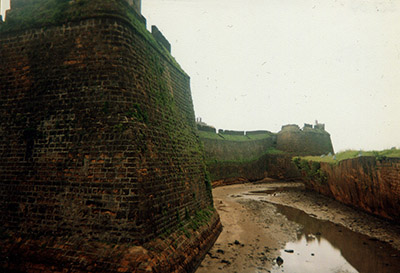 Diu Fort's northwest bastion, enpicted in the dust-besotted pre-digital age. Diu Fort's northwest bastion, enpicted in the dust-besotted pre-digital age. |
 |
Diu Fort's western side is the only section not bordered by the sea, and a double moat was cut into the sandstone along that wall to protect it: The outer moat was tidal, and the inner one was likely quite odoriferous.
The spiritual needs of Diu Fort's garrison were amply provided for by the inclusion of three chapels within the fort's walls. Three chapels. This is not a particularly a large fort. Yet it had three chapels. Moving on.
Badhur Sultan soon had well-founded misgivings about his "alliance" with the Portuguese, and was killed in a "fracas" with those "allies" in 1537. The Portuguese somehow convinced the new Sultan to agree to a truce, which would last for a brief period. |
|
The Ottoman Turks, the bug-a-boos of anyone trying to accomplish anything in the Middle East from the 14th through the 18th centuries, got involved in the Diu-dominating business in 1538. A Turkish naval force of 66 ships with 20,000 men descended upon Diu early that year, besieging and bombarding the fort for a few exciting months. When Diu Fort's Portuguese defenders had been whittled down to 40 out of it's original garrison of 400 and defeat seemed imminent, the Turks inexplicably departed, never to return.
Perhaps interested in taking advantage of the weakened Portuguese garrison, the Sultan attacked the fort in June of 1538, but was repelled. Other rulers of Gujurat attempted to wrest the fort from the Portuguese in 1545 and 1546, but these were dudes without artillery attacking a starfort, and few knew how to build and defend 'em better than the Portuguese, particularly in the mid-16th century.
|
And 'twas for this reason that everybody gave up trying to take Diu Fort away from the Portuguese for the next 400 years...aside from an incident in 1670, when an armed group of bandits from Muscat did manage to pillage the town and the fort, but that doesn't really count because they weren't interested in capturing the fort.
In the following centuries India was more or less subjugated by Great Britain, a process that finally ended with independence in August of 1947...but it was independence from Great Britain. Portugal, not getting the memo stating that the colonialism thing was over, still held onto Goa, Daman and Diu, which were collectively known as the Estado de Índia.
|
 |
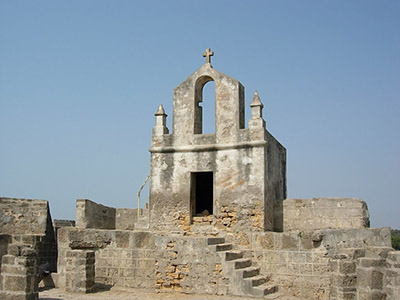 One of Diu Fort's 74 chapels. One of Diu Fort's 74 chapels. |
|
The government of India began gently prodding Portugal to leave the subcontinent in the late 1940's, but having been there since the end of the 15th century, the Portuguese strongly felt that the bits of India they had claimed as their own were well and truly their own, and didn't intend to go anywhere.
|
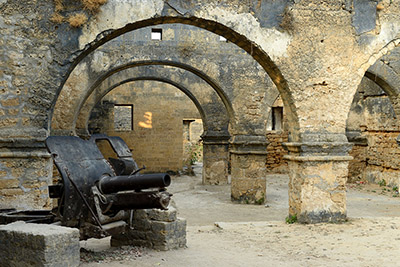 Diu Fort's impressive innards, home to a dilapidated gun of a 20th-century vintage. Diu Fort's impressive innards, home to a dilapidated gun of a 20th-century vintage. |
 |
India set about making things increasingly difficult for the Portuguese in the places the Indians wished they (the Portuguese) weren't, and took military action in 1954 to recapture Dadra and Nagar Haveli, two inland enclaves in Daman, to the east of Diu. Economic blockades against the Estado de Índia followed.
When Operation Vijay (the Indian military exertion that ejected the Portuguese from India) finally came about in 1961, the defending Portuguese were anything but ready for the challenge. Much of the Portuguese populace was uncertain as to the wisdom of retaining the remaining teeny pieces of their formerly vast empire into eternity, and reinforcements were not forthcoming. |
|
Portuguese Prime Minister António de Oliviera Salazar (1889-1970) essentially told the 3300 troops in India that the best way they could serve their country would be to take one for the team and die, as they had no chance of resisting a determined attack by the Indian military. What Salazar actually told them to do was to hold out for eight days, during which time he hoped to rally public opinion at home and create the political opportunity to properly reinforce his troops.
|
But the Estado de Índia didn't have eight days. Combined Indian land, air and naval assaults took Goa on December 18, 1961, and Daman the following day. The Indian cruiser INS Delhi bombarded the starfort of our current interest with its 6-inch guns on the morning of December 18, and Indian fighter jets fired rockets at a mortar position in the fort, which started a fire near the fort's munitions dump and prompted its Portuguese garrison of 350 men to flee into captivity.
The Portuguese officially surrendered on December 19, ending their 451 year rule of a few small, yet significant bits of India. The war had lasted two days and cost 30 Portuguese and 22 Indian lives.
|
 |
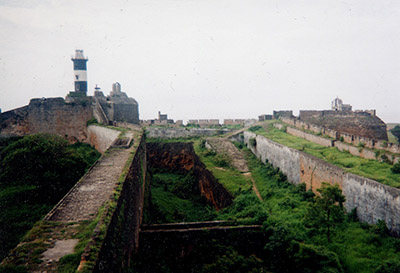 Diu Fort's lighthouse and a section of the delicious moat, which was good for defense against 16th century Indians, but not 20th century ones in fighter jets. Diu Fort's lighthouse and a section of the delicious moat, which was good for defense against 16th century Indians, but not 20th century ones in fighter jets. |
|
Today, most Diu Fort is open to the public, though some of it serves as Diu Island's jail. The fort's lighthouse is accessible, and is the highest point in Diu. Many cannons still sit atop Diu Fort's walls and are littered attractively about the grounds, in addition to a liberal sprinkling of loose cannonballs. The fort is reported to be in relatively good repair, though erosion is naturally having its way with the walls.
|
|
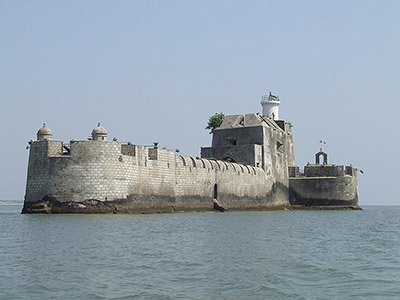 Toot toot! Toot toot! |
 |
Also known variously as Panikotha Fortim do Mar and the Forte de Santo António de Simbor (although that name appears to be shared with another fort 20 miles to the east), Panikota is a ship-shaped fortlet built in the entrance to the Bay of Simbor, about one nautical mile north of Diu Fort. Precisely when this adorable fort was built seems to be a well-kept secret, but it was built by the Portuguese and the rulers of Gujurat, in order to help Diu Fort in resisting an imagined invasion from the Mughal Empire. |
|
An additional teeny fort built in such close proximity to a powerhouse like Diu Fort seems strange, but given the relatively short range of artillery in the 16th & 17th centuries, it's surprising that EVERY strategic body of water didn't have twelve little forts strung along to protect it.
|
Panikota had an integrated lighthouse, many dank cells that were used to lock folks up, and, of course, a chapel. During Operation Vijay in 1961, Panikota was manned by a mighty force of sixteen dudes who, though unattacked, returned to Diu Fort and surrendered.
It is today a tourist hotspot, reachable only by boat, and lit up in a most decorative and celebratory fashion at night.
|
 |
|
|
|
|
|
|
|
 |




